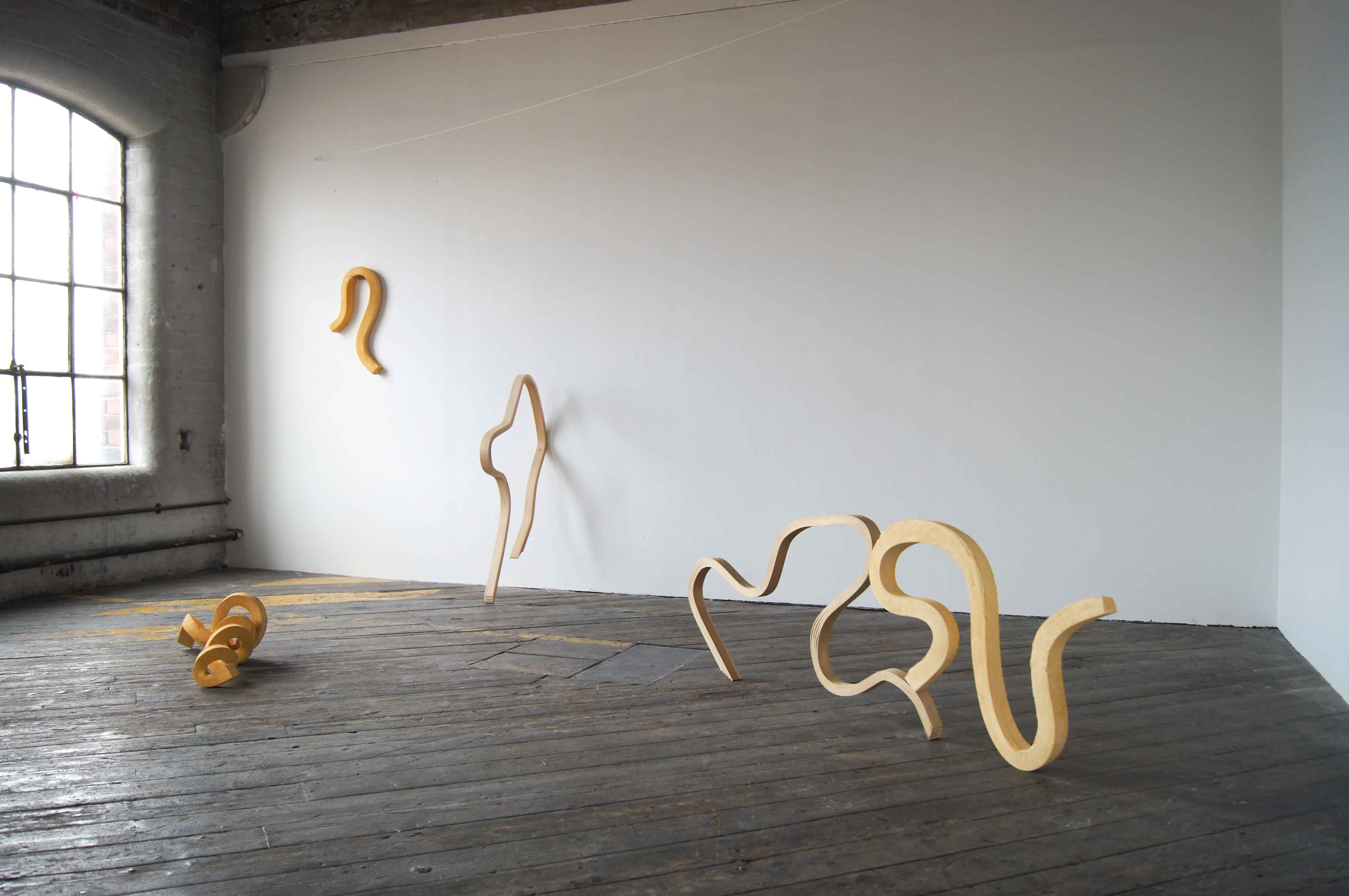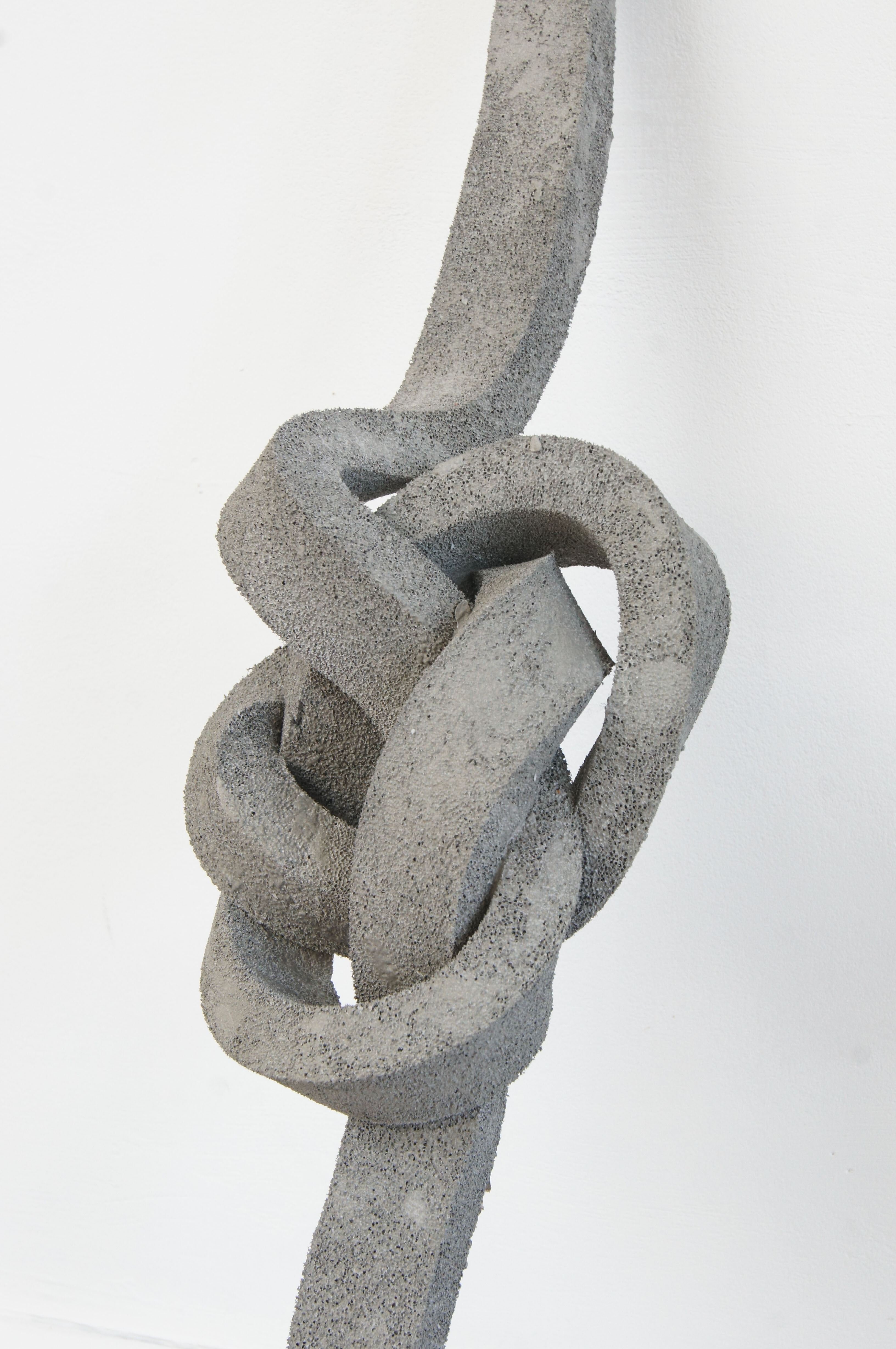Emily Stollery
Interview by Pippa Eason
-
Published September 2019
-
Led by the
seductive properties of materials, process and assemblage run in parallel
in order for the work to emerge somewhere in-between. Materials meet instinct
to create forms born out of spontaneity; the in the moment to
and fro of maker and material.
How it feels,
functions,
breaks.’
-Emily Stollery
-
How it feels,
functions,
breaks.’
-Emily Stollery
 Hold 2, 3, 4, tulip wood, adhesive, oil, concrete, pigment, foam, dowel, screw, dimensions variable, 2019
Hold 2, 3, 4, tulip wood, adhesive, oil, concrete, pigment, foam, dowel, screw, dimensions variable, 2019Hi Emily! I have had the pleasure of following your work for some time now, and I wanted to try and get to know your processes, and material interests. You’ve been making a lot lately, and the purpose of me talking to you is to try and get some context for all this making you’re doing, and to get into your artist mind. I’m going to keep the questions fairly broad for you to expand on them in as much detail as you wish.
It feels as if you like to test the boundaries of materials, to push them and reconfigure their meaning. What led you to this way of working?
Yeah, that’s absolutely right, and I think it's something that I began exploring back on my foundation course. It at first stemmed from an interest in solidifying movement in a material, making something solid seem fluid, and has unravelled from there. I haven’t always made sculpture, through university I explored numerous different avenues, but even whilst I was making films, sculpture was present. And it progressed from film/soundscapes, to sculptures projecting sound, to then purely focussing on form. It took me a while to trust the work to stand alone as this one thing, and give it the space to breathe and perform as it does now. But anything I make always begins with an interest in material(s). I love to work with materials I can really get hands on with, manipulate, and exploit these boundaries as you’ve said.
Performity seems like a huge element of this process. Explain more…
I like that you’ve picked up on this, because sometimes I think there’s a subtlety to my work where this can be overlooked. But I often see my staging process as very performative. The process I go through is again, usually unplanned, so that I can be in the moment, with the work and the space. And it’s there where these relationships begin to unfold in the work. Installations of mine often look as if a performative action has taken place. But the audience never encounters it live.
 Stomach in knots and feeling tongue tied (detail), concrete, foam. dimensions variable, 2018
Stomach in knots and feeling tongue tied (detail), concrete, foam. dimensions variable, 2018Yes, you seem to have a very intuitive relationship to form, and to letting the materials organically guide your practice. What was the content of the films you made during university? And will we perhaps see them again at some point? Seeing sculptors work with film usually has unique and ambiguous outcomes.
I always describe this relationship as the ‘to and fro’ between maker and material- all materials have limits. Sometimes it works with you, other times against you. Of course this can lead to a somewhat ‘in the moment’ way of making, but I like this energy of not quite knowing what the resulting form will be.
Regarding the filmwork, these often depicted abstract landscapes, incorporating ASMR soundscapes to create feelings of unease and relaxation. Whilst right now I can’t place these kinds of themes in my current work, I wouldn’t rule out video as a whole. I love documenting my work, film just progressed naturally from that side of my practice.
The main reason I have an interest in seeing you work with video is because the forms feel kinetic, they have a fluidity and personality, they don’t take themselves too seriously, yet they have a totally natural confidence.
I totally agree, I often see the forms I make as characterful. They almost develop traits when they’re staged in a space- it isn’t something made with initial intention. Some have strength, others are softer and more discreet. I believe their confidence comes from the way they’re staged. My final year at university was when I began to trust these forms to purely exist on their own. A minimal approach isn’t something I was used to but have become more comfortable with over time, and is something I continue to develop now.
But as a response to the materiality of your work; as a maker myself, I can reiterate that materials definitely have limits. It could perhaps depend on the chosen outcome for the materials. I also feel there is a lot of pressure to have polished and slick sculptural works at the moment. Have you noticed the fairly rapid change in the way sculpture is being made, what with the rising use of 3D printers, etc?
Mmm yes, I know what you mean. As technology and fabrication becomes more and more integrated into sculptural production, there is sometimes a pressure for works to have ‘finesse’. Slick works are definitely something I’m seeing a lot more of, but my practice has always gone against some of the principles of this. Whilst I like to make aesthetically pleasing works and works with tactility, my work also demonstrates the limits of these materials. I openly involve the imperfections of surfaces and processes, it’s a way of opening up the honesty of making to the viewer; something rarely seen when a work is pristinely displayed in a space. In many cases, the visible struggle of the making is what I enjoy the most in my work, not only in process, but in result.
 Soft Touch, concrete, foam, plaster, pigment, dimensions variable, 2018
Soft Touch, concrete, foam, plaster, pigment, dimensions variable, 2018I can also align closely with the notion of avoiding being too slick, and going against the pressures of conformity, or trends. I can see you relish the hands-on elements of making. With that said, I want to know more about the actual process of these beautiful twists, turns, knots, and wiggles. I have seen some of the casting processes, and the incredibly fragile nature of the finished works. But like you said, the invisible struggle is usually the most intriguing part of making.
Tell me about a typical day in the studio for you…
A typical day in the studio. I don’t suppose I really have a typical day. What I’m doing varies greatly from day to day. If I have something I’m working towards I always feel like I have more direction, and I feel more focused. But of course I love those experimental days where I just come in with no plan, just the idea to play. I’m definitely someone who needs to at least make something, anything, in order to keep my practice and ideas ticking over. I’m also definitely that person that thrives in a productive mess- I love being hands on with my materials, I love it when my studio looks busy and yeah, messy sometimes!
As far as any planning goes, I would decide on a material, a pigment and a process. The form itself isn’t planned other than the basics- for instance I might decide on making a knot, or a bend. Even when I have to lay out a jig to steam bend wood, that can drastically change in that crucial moment. More often than not I’m frantically trying to juggle the piece and a drill as I maneuver the form around the jig. The processes I use can be ridiculously spontaneous, but I love this energy, even when it goes completely wrong.
Your practice has an energy that translates from your studio gesture, and gently illustrates your love for thinking via making. It seems as if you quench the thirst of playing, making and creating a choreographed mess in the studio, with each form made. The spontaneous element of your outputs is what drew me in. One piece I had a fondness for was when you left a track of residue behind the piece, do you think this raw vulnerability might occur more with your installations in the future?
Absolutely. I think more recently my practice is becoming a little more gritty, in the sense of exposing this studio practice and ‘considered mess’ more in the work itself. No longer trying to ‘tidy up’ works as much in the aim of something more perfect.
Residencies and working away from my studio are always extremely fruitful times for me. Some of my working techniques are hard to transfer from place to place, so it always breaks me out of my norm. The piece you’re referring to (You chewed me up and spat me out- like bubblegum) felt very new for me and I loved the rawness and emotive feeling in the work. The work was made on site for an exhibition in the Netherlands, and it’s definitely something I want to explore and expand upon more. For me, that work felt very present in the space. Again, that performative action that the viewer may have just missed. Even in its delicate nature it demanded attention.
 You chewed me up and spat me out- like bubblegum (detail), concrete, pigment, foam, screw, dimensions variable, 2019
You chewed me up and spat me out- like bubblegum (detail), concrete, pigment, foam, screw, dimensions variable, 2019I can see how you’re venturing into some grittiness with your making style. Your work celebrates form, and the evolution of thought process in one marvellous mashup.
I want to ask about your recent achievements before we end this discussion, tell us more about the Pangaea Sculpture Production Award and New Contemporaries! I’m very excited for you.
I’m really excited about both of these projects unfolding. I’ll be exhibiting my degree show with New Contemporaries, which opens in Leeds this September and then moves on to London in December. It’s the first touring exhibition I’m involved in, and I’m really looking forward to seeing the exhibition come together.
The Pangaea Sculpture Production Award is allowing me to create a new piece of work with a fabricator. I’ve never involved fabricators in my practice, so this in itself is really exciting for me. Strange in a way, I kind of feel like I’m letting go of the work a little bit as I myself aren’t making it. My proposal was to create a bronze of one of my forms, as I wanted to challenge the fragility and longevity of my recent work. So I’m going to be in residence with a foundry soon where I can try out some ideas and play with some of these new materials. I’m really looking forward to it. The resulting work will be shown in my first solo exhibition early next year, with Four/Four Collective.
Oh wow! Congratulations for both. And a fabricator taking on those studio gestures! It’s bound to be a fascinating outcome, particularly in bronze. Perhaps shifting into something so solid will change contexts, altering the way we view the forms entirely. Its brave that you are venturing into this realm, one of mystery, one without control. Who knows where your practice will end up, and that’s why I’m in awe.
-
emilystollery.weebly.com
-
If you like this why not read our interview with Tom Cardew
-
© YAC | Young Artists in Conversation ALL RIGHTS RESERVED
